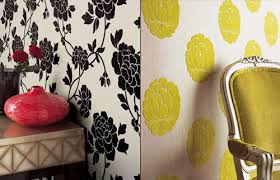Starch Fabric Wallpaper Biography
The earliest wallpapers used in Europe as early as the thirteenth century were painted with images of popular religious icons. These "domino papers" were pasted within homes of the devout; however, they also enlivened the bleak homes of the poor. Within the next few centuries, papers were hand block-printed, but only remained popular with the poor.
By the sixteenth century, however, more expensive wallcovering, depicting tapestries hung in homes of nobility, became popular with the middle class. Small sheets either carried a repeating image, or several blocks produced a pattern spread across many sheets. Fashionable eighteenth century Americans puchased wallpapers from France and England; "paper stainers" were producing wallpapers in this country by the early nineteenth century if not before.
Two problems plagued wallpaper stainers until the mid-nineteenth century. One was the problem of producing long sheets of paper for printing, the other was printing attractive wallpaper inexpensively. Until the mid-1700s, rag-based paper was individually printed in sheets, then applied to walls. Then, wallpaper manufacturers were pasting the pieces together, ground coating them, then printing. In the late nineteenth century, the paper industry developed "endless" paper, or paper made in very long strips. By 1870, wood pulp had supplanted rag stock, resulting in a very cheap backing for wallcovering.
In the nineteenth century, printing costs were greatly reduced by abandoning labor-intensive block printing in favor of cylinder printing. Wood-block printers applied each color by hand using a separate block for each color in the pattern. Thus, each block had to be inked with the right color, pressed down on the paper, tapped to ensure a quality imprint, lifted up, and reinked as the printer moved down the paper roll—an expensive process. Wood blocks were supplanted by copper cylinders, which carried the design below the surface of the roll, each roll printing a single color. The cylinders were mounted within one machine and the paper was mechanically fed between cylinders until the paper was completely printed—no hand printing involved. Thus, by about 1885 wood pulp paper printed with cylinders so greatly reduced wallpaper costs that it was cheaper to wallpaper a house in the United States than to paint it.
More recent advances include development of additional printing methods, new inks and solvents, and use of latex and vinyl as coatings or laminates








The earliest wallpapers used in Europe as early as the thirteenth century were painted with images of popular religious icons. These "domino papers" were pasted within homes of the devout; however, they also enlivened the bleak homes of the poor. Within the next few centuries, papers were hand block-printed, but only remained popular with the poor.
By the sixteenth century, however, more expensive wallcovering, depicting tapestries hung in homes of nobility, became popular with the middle class. Small sheets either carried a repeating image, or several blocks produced a pattern spread across many sheets. Fashionable eighteenth century Americans puchased wallpapers from France and England; "paper stainers" were producing wallpapers in this country by the early nineteenth century if not before.
Two problems plagued wallpaper stainers until the mid-nineteenth century. One was the problem of producing long sheets of paper for printing, the other was printing attractive wallpaper inexpensively. Until the mid-1700s, rag-based paper was individually printed in sheets, then applied to walls. Then, wallpaper manufacturers were pasting the pieces together, ground coating them, then printing. In the late nineteenth century, the paper industry developed "endless" paper, or paper made in very long strips. By 1870, wood pulp had supplanted rag stock, resulting in a very cheap backing for wallcovering.
In the nineteenth century, printing costs were greatly reduced by abandoning labor-intensive block printing in favor of cylinder printing. Wood-block printers applied each color by hand using a separate block for each color in the pattern. Thus, each block had to be inked with the right color, pressed down on the paper, tapped to ensure a quality imprint, lifted up, and reinked as the printer moved down the paper roll—an expensive process. Wood blocks were supplanted by copper cylinders, which carried the design below the surface of the roll, each roll printing a single color. The cylinders were mounted within one machine and the paper was mechanically fed between cylinders until the paper was completely printed—no hand printing involved. Thus, by about 1885 wood pulp paper printed with cylinders so greatly reduced wallpaper costs that it was cheaper to wallpaper a house in the United States than to paint it.
More recent advances include development of additional printing methods, new inks and solvents, and use of latex and vinyl as coatings or laminates
Starch Fabric Wallpaper

Starch Fabric Wallpaper
Starch Fabric Wallpaper

Starch Fabric Wallpaper

Starch Fabric Wallpaper

Starch Fabric Wallpaper
Starch Fabric Wallpaper

Starch Fabric Wallpaper

Starch Fabric Wallpaper.
Removing Temporary Wallpaper
Calico DIY: How to Upholster Walls
No comments:
Post a Comment